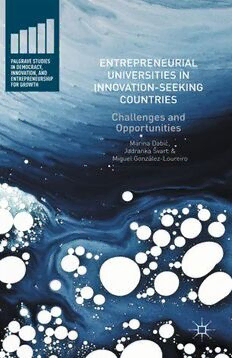
Entrepreneurial Universities in Innovation-Seeking Countries PDF
Preview Entrepreneurial Universities in Innovation-Seeking Countries
PalgraveStudiesinDemocracy,Innovation,and EntrepreneurshipforGrowth SeriesEditor:EliasG.Carayannis Thecentralthemeofthisseriesistoexplorewhysomeareasgrowandothers stagnate, and to measure the effects and implications in a transdisciplinary context that takes both historical evolution and geographical location into account.Inotherwords,when,how,andwhydoesthenatureanddynamics of a political regime inform and shape the drivers of growth and especially innovation and entrepreneurship? In this socioeconomic and socio-technical context,howcouldwebestachievegrowth,financiallyandenvironmentally? Thisseriesaimstoaddresssuchissuesas: ● Howdoestechnologicaladvanceoccur,andwhatarethestrategicprocesses andinstitutionsinvolved? ● How are new businesses created? To what extent is intellectual property protected? ● Which cultural characteristics serve to promote or impede innovation? Inwhatwaysiswealthdistributedorconcentrated? These are among the key questions framing policy and strategic decision- makingatfirm,industry,national,andregionallevels. Aprimaryfeatureoftheseriesistoconsiderthedynamicsofinnovationand entrepreneurship in the context of globalization, with particular respect to emerging markets, such as China, India, Russia, and Latin America. (For example,whataretheimplicationsofChina’srapidtransitionfromproviding low-costmanufacturingandservicestobecominganinnovationpowerhouse? Howdotheperspectivesofhistoryandgeographyexplainthisphenomenon?) Contributions from researchers in a wide variety of fields will connect and relate the relationships and interdependencies among (1) innovation, (2) political regime, and (3) economic and social development. We will consider whether innovation is demonstrated differently across sectors (e.g., health, education, and technology) and disciplines (e.g., social sciences and physical sciences), with an emphasis on discovering emerging patterns, fac- tors, triggers, catalysts, and accelerators to innovation, and their impact on futureresearch,practice,andpolicy. Thisserieswilldelveintowhatarethesustainableandsufficientgrowthmech- anismsfortheforeseeablefuturefordeveloped,knowledge-basedeconomies and societies (such as the EU and the United States) in the context of mul- tiple,concurrent,andinterconnected“tipping-point”effectswithshort-term (MENA)aswellaslong-term(ChinaandIndia)effectsfromageostrategic, geoeconomic,geopolitical,andgeo-technologicalsetofperspectives. Thisconceptualizationliesattheheartoftheseries,andofferstoexplorethe correlationbetweendemocracy,innovation,andgrowth. BooksAppearinginthisSeries: UnpackingOpenInnovation:HighlightsfromaCo-EvolutionaryInquiry ManlioDelGiudice,EliasG.Carayannis,andMariaRosariaDellaPeruta TheEntrepreneurialRiseinSoutheastAsia:TheQuadrupleHelixInfluenceon TechnologicalInnovation StavrosSindakisandChristianWalter UncertaintyinEntrepreneurialDecisionMaking:TheCompetitiveAdvantages ofStrategicCreativity PanagiotisE.PetrakisandDimitraP.Konstantakopoulou EntrepreneurialUniversitiesinInnovation-SeekingCountries:Challengesand Opportunities MarinaDabic´,JadrankaŠvarc,andMiguelGonzález-Loureiro Entrepreneurial Universities in Innovation-Seeking Countries Challenges and Opportunities Marina Dabic´, Jadranka Švarc, and Miguel González-Loureiro ENTREPRENEURIALUNIVERSITIESININNOVATION-SEEKINGCOUNTRIES Copyright©MarinaDabi´c,JadrankaŠvarc,andMiguelGonzález-Loureiro 2016 Allrightsreserved.Noreproduction,copyortransmissionofthis publicationmaybemadewithoutwrittenpermission.Noportionofthis publicationmaybereproduced,copiedortransmittedsavewithwritten permission.InaccordancewiththeprovisionsoftheCopyright,Designs andPatentsAct1988,orunderthetermsofanylicencepermittinglimited copyingissuedbytheCopyrightLicensingAgency,SaffronHouse, 6-10KirbyStreet,LondonEC1N8TS. Anypersonwhodoesanyunauthorizedactinrelationtothispublication maybeliabletocriminalprosecutionandcivilclaimsfordamages. Firstpublished2016by PALGRAVEMACMILLAN Theauthorshaveassertedtheirrightstobeidentifiedastheauthorsofthis workinaccordancewiththeCopyright,DesignsandPatentsAct1988. PalgraveMacmillanintheUKisanimprintofMacmillanPublishersLimited, registeredinEngland,companynumber785998,ofHoundmills, Basingstoke,Hampshire,RG216XS. PalgraveMacmillanintheUSisadivisionofNatureAmerica,Inc.,One NewYorkPlaza,Suite4500,NewYork,NY10004-1562. PalgraveMacmillanistheglobalacademicimprintoftheabovecompanies andhascompaniesandrepresentativesthroughouttheworld. HardbackISBN:978–1–137–57981–2 E-PUBISBN:978–1–137–57983–6 E-PDFISBN:978–1–137–57982–9 DOI:10.1057/9781137579829 DistributionintheUK,EuropeandtherestoftheworldisbyPalgrave Macmillan®,adivisionofMacmillanPublishersLimited,registeredin England,companynumber785998,ofHoundmills,Basingstoke, HampshireRG216XS. LibraryofCongressCataloging-in-PublicationData Names:Dabi´c,Marina,author. | Švarc,Jadranka,author. | González-Loureiro,Miguel,1974–author. Title:Entrepreneurialuniversitiesininnovation-seekingcountries: challengesandopportunities/MarinaDabic,JadrankaSvarc,Miguel González-Loureiro. Description:NewYork,NewYork:PalgraveMacmillan,2016. | Series: Palgravestudiesindemocracy,innovation,andentrepreneurshipfor growth | Includesindex. Identifiers:LCCN2015031092 | ISBN9781137579812(hardback) Subjects:LCSH:Academic-industrialcollaboration—Croatia—Case studies. | Academic-industrialcollaboration—Spain—Casestudies. | Education,Higher—Aimsandobjectives—Croatia—Casestudies. | Education,Higher—Aimsandobjectives—Spain—Casestudies. | BISAC: BUSINESS&ECONOMICS/Entrepreneurship. | EDUCATION/Higher. Classification:LCCLC1085.4.C76D332016 | DDC378.1/035—dc23LC recordavailableathttp://lccn.loc.gov/2015031092 AcataloguerecordforthebookisavailablefromtheBritishLibrary. Contents ListofTables,Figures,andCasestudies vii Preface xi Acknowledgments xiii ExecutiveSummary xv 1 TowardaNewUniversityParadigm 1 2 AntecedentsofEntrepreneurialUniversities:Fromthe FirstIndustrialRevolutiontoKnowledgeEconomy 47 3 CriticsofUniversity–IndustryInteractionand CommercialApplicationofScience 65 4 TheoriesofTransitioninScientificSystems 71 5 ActivitiesofEntrepreneurialUniversities 91 6 AssessmentoftheEntrepreneurialUniversityConcept amongCroatianandSpanishAcademics 129 7 EntrepreneurialUniversityinInnovation-Seeking Countries:LessonsLearned 193 8 OutlooksandConclusionsonEntrepreneurial UniversitiesinInnovation-SeekingCountries 201 Notes 219 References 223 AbouttheAuthors 243 Index 245 Tables, Figures, and Case studies Tables 1.1 Reviewofthetenmostcitedpaperswiththetitlesof papersandthepublishingjournals 14 1.2 Themostrepresentedauthor’skeywords 15 1.3 Top-tensubjectareas 16 1.4 Newrulesofthegameforuniversitiesinrespectof newknowledgeproduction 27 1.5 KIdynamicsbycountry(1995–2000–2009)in descendingorderby%changeinKI(1995–2009) 38 1.6 KEIdynamicsbycountry(1995–2000–2009)in descendingorderby%changeinKEI(1995–2009) 43 2.1 Theevolutionofsocietiesduringthethreeindustrial revolutions 50 4.1 ThedifferencesbetweenMode1andMode2of knowledgeproduction 73 4.2 Normsinmodelsof“scholar”and“qualified scientistandengineer” 74 5.1 Someexamplesofthebusinessincubation associations 111 6.1 Someselectedindicatorsofresearchandinnovation systemforCroatiaandSpainincomparisontothe EU(2013orclosest) 138 6.2 MainbarrierstoR&DinvestmentsinCroatiaand Spain 140 6.3 Definitionsofentrepreneurialuniversityinthesurvey 150 6.4 Barriersandneedsofentrepreneurialuniversities 158 6.5 Openresponsesto:whicharethemost entrepreneurialuniversities? 163 viii List of Tables, Figures, and Case studies Figures 1.1 NumberofpapersperyearincludingA&EandU&E 9 1.2 Scientificcontributionsbyyearofpublication 10 1.3 Scientificcontributionsbytype 11 1.4 Leadingjournalspublishingmaterialson entrepreneurialuniversities(includingalljournals withtenormorearticles) 11 1.5 Totalcitationsforeachauthor(includingallhis/her papers) 12 1.6 Spacesforreflection 33 1.7 KIindexesbycountry:1995vs.2009 35 1.8 KEIindexesbycountry:1995vs.2009 41 4.1 Typesofpartnerinstitutionswithwhichcooperation wasratedbyenterprisesasthemostbeneficialfor innovationactivitiesastheshareofenterprises,which hadanycooperationininnovationactivity:Industrial enterprisesinPoland,2006–2012(inpercentage) 88 4.2 Typesofpartnerinstitutionswithwhichcooperation wasratedbyenterprisesasthemostbeneficialfor innovationactivitiesastheshareofenterpriseswhich hadanycooperationininnovationactivity:Service sectorenterprisesinPoland,2006–2012 (inpercentage) 88 6.1 Innovationscoreboard:SPAINcomparedtoEU-28 score(EU-27=100) 135 6.2 Innovationscoreboard:CroatiacomparedtoEU-28 scoreEU-27=100) 136 6.3 Numberofresearchers(%)in2012 137 6.4 Definitionthatbestdescribesthepersonalviewof whatanentrepreneurialuniversityis 151 6.5 Definitionthatbestdescribesthepersonalviewof whatanentrepreneurialuniversityis(breakdownby countryofpolledprofessors) 154 6.6 Doyoubelievethatsomefacultiesaremoresuitable forgeneratingtheirownincome? 156 6.7 Relevanceofbarriershinderinguniversitiesbeing moreentrepreneurial 159 6.8 Relevanceofneedstomakeuniversitiesmore entrepreneurial 162 6.9 ChangesduetoBologna 165 6.10 Impactofbudgetcutsondepartmentactivities 166 List of Tables, Figures, and Case studies ix 6.11 Pedagogicalchangesresultingfromtheintroduction oftheBolognaprograms 167 6.12 Assessmentofchangesduetotheintroductionofthe Bolognaprograms 168 6.13 Priorityfornewfundinginteachingsupport 169 6.14 Priorityfornewfundinginresearchsupport 170 6.15 AttitudesinCroatianandSpanishuniversities concerningentrepreneurialorientation(1of4) 173 6.16 AttitudesinCroatianandSpanishuniversities concerningentrepreneurialorientation(2of4) 175 6.17 AttitudesinCroatianandSpanishuniversities concerningentrepreneurialorientation(3of4) 175 6.18 AttitudesinCroatianandSpanishuniversities concerningentrepreneurialorientation(4of4) 176 6.19 Positionoccupiedbytheprofessorspolled 178 6.20 Numberofyearsinthecurrentposition 178 6.21 Percentageofpotentialintrapreneurprofessorsinthe sample 179 6.22 Awarenessofspin-offactivitiesamongprofessorsin thesample 180 6.23 Percentageofprofessorswithinternationalscientific experienceofprojectsandfundinginthelast fiveyears 180 6.24 Percentageofnationalscientificprojectsandgrants inthelastfiveyears 181 6.25 PercentageofgrantholdersandpartnersinEU projectsamongthesample 181 6.26 Technologyprojectholders 182 6.27 Percentageofprofessorswhohaveprivatesector experience 183 6.28 Agreementonintellectualproperty 183 6.29 Degreeofsupportfrominstitutions 184 6.30 Percentageofprofessorswhohavespentmorethan sixmonthsabroadengagedinscientificwork 185 6.31 Percentageofprofessorswhowouldliketospend timeworkingabroad 186 6.32 Genderandageofindividualsinthesample 187 8.1 Anapproachtoinputs,processes,andoutputsfor universitymanagerstospeeduptheshifttowarda moreentrepreneurialuniversity 213 x List of Tables, Figures, and Case studies Casestudies 4.1 TheUniversityofVigo:Anexampleoftriple-helix modelinpractice 83 4.2 AssessingtheEntrepreneurialOrientationof UniversityDepartments:Acomparativestudy betweenItalyandSpain 84 4.3 Howrelationsbetweenindustryandsciencehave beenevolvinginPolandintheyears2006–2012 87 5.1 UniversityMiguelHernándezdeElche(Spain):The caseofanentrepreneurialuniversity 92 5.2 Howtoencourageentrepreneurialuniversities: AnexamplefromtheUnitedKingdom 93 5.3 UniversityofHertfordshire:Winner2010 95 5.4 Knowledgetransferthroughthecreationofspin-offs attheUniversityofOviedo 104 5.5 Sophia-Antipolis,France 109 5.6 STEPRijeka,Croatia 111 5.7 Astrategyofresearch,development,andinnovation attheUniversityofValladolid 113 5.8 TheInnovationInfrastructureDevelopment ProgramattheNationalResearchUniversityHigher SchoolofEconomics,Moscow,RussianFederation 115 5.9 TheHIVEStudentDevelopmentProgrammeat NottinghamTrentUniversity,theUnitedKingdom 116 5.10 UniversitatRoviraIVirgili:Buildingaknowledge regioninTarragona 125 5.11 Chalmersasanentrepreneurialuniversity 126
